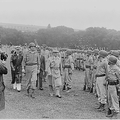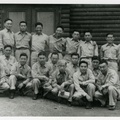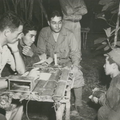Washington, DC. The military record of Japanese Americans who served during and since World War II is well documented and known. However, the role of ethnic Japanese in the military prior to the Second World War and their quest for naturalization has received scant publicity. Nine Japanese immigrants served in the US Maine which sank in the harbor at Havana, Cuba, in 1898 during the Spanish American War. All of them, who had served as mess attendants, steerage cooks, warrant officer cooks, and wardroom stewards, sank with the vessel.
When America entered World War I to fight against Germany on April 5, 1917, a call was announced in Hawaii inviting “nationals of allied countries,” or “friendly aliens,” to enlist in the Hawaii National Guard. Announcements which were printed in all newspapers in Japanese and other ethnic languages suggested that military service could help them become naturalized American citizens.
There were three recruitment drives, on July 27, 1917, July 31, 1918 and October 26, 1918. The first recruitment day was declared a holiday. Sugar plantations supported the voluntary enlistments, provided recruitment booths, transportation, places to store equipment and supplies, drill fields, target ranges, and money. Approximately 29,000 registered to join the military service. Of this number, 11,000 were immigrant Japanese and Nisei of which 838 were finally accepted for service.
Because of this large number, the ethnic Japanese were placed in a separate company, Company D. Other Asian ethnic groups, such as Chinese, Koreans and Filipinos also served in respective companies based on ethnicity. The Japanese language was used for both written and oral communication in Company D. A Japanese immigrant, Kinichi Sakai, was among the first Japanese to become a commissioned officer, rising to the rank of Captain and commanding the company. The Government of Japan endorsed and assisted in the registration and also the sale of liberty bonds and war saving stamps.
Hawaii National Guard personnel were not sent overseas. They relieved Caucasian soldiers, thus freeing them for deployment to France. Shigefusa Kanda, a Japanese immigrant of Maui, was the only known Japanese Red Cross worker to serve in France. A resident of Hawaii for 14 years he felt it “his duty to make some repayment to America for the advantages he had enjoyed.” Red Cross officials were full of praise for Kanda’s performance.
The principal motivation of Japanese aliens to serve in the US military was to gain US citizenship. The Act of May 9, 1918, provided that any alien soldier “of the white race” or “of African descent,” who served in the US military was eligible to become naturalized US citizens. W.R. Ragsdale, US Naturalization examiner in Honolulu, ruled that “oriental veterans” were not eligible for naturalization. However, Honolulu US District Judge W. Vaughan, interpreted the law differently and allowed 400 Japanese immigrants to be naturalized on November 14, 1919. After Judge Vaughn’s six-year term expired in May 1922, the territorial government announced that aliens were ineligible to be naturalized and thus voided Judge Vaughn’s decision. Hidemitsu Toyota, a Japanese alien veteran, who served in the US Army for seven years, filed a petition for naturalization. On May 25, 1925 the US Supreme court ruled against Toyota saying that a person of the Japanese race may not be naturalized under the Act of May 9, 1918.
The actual number of Japanese immigrants on America’s mainland who volunteered for military service during World War I cannot be fully determined. However, the number is believed to be small as compared to Hawaii. One Japanese immigrant who fought with the 328th Infantry Regiment, 82nd Division at Meuse-Argonne and St. Mihiel, France, was Sergeant Major Tokutaro Nishimura Slocum.
Tokutaro Nishimura’s parents had brought him to America in 1904 and settled in Minot, North Dakota. Tokutaro’s parents moved to Canada to escape discrimination, leaving him with the Slocum family who adopted and raised him. In January 1921, Slocum visited the office of the chief examiner of naturalization at St. Paul, Minnesota, to apply for US citizenship. The examiner “conceded that Slocum had an excellent character and an excellent army record,” but he informed Slocum that he was not eligible for citizenship.
According to the examiner, Slocum “burst into tears” and exclaimed, “I know what you mean; you mean that I am yellow. I may be yellow in face, but I am not yellow at heart.” Slocum subsequently visited the US Congress and the result of his efforts was the passage of the Nye-Lee Act of June 24, 1935, which granted naturalization to 500 Asian immigrant World War I veterans, including the 400 Japanese immigrants whose citizenship was revoked by the Hawaii legislature.
The long and arduous road for ethnic Japanese immigrants, as well as other Asian immigrants, to be naturalized as US citizens finally came to an end with the passage of the 1952 Immigration and Nationality Act (McCarran-Walter Act), which ended the blanket exclusion of immigrants based on simply on the country of origin.
*This article was originally published in the JAVA Advocate in Fall 2015 Volume XXIII - Issue III.
© 2015 JAVA Advocate






